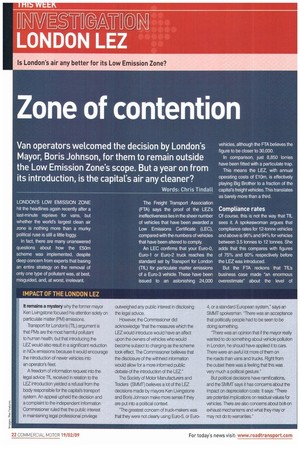Zone of contention
Page 22

Page 23

If you've noticed an error in this article please click here to report it so we can fix it.
Van operators welcomed the decision by London's Mayor, Boris Johnson, for them to remain outside the Low Emission Zone's scope. But a year on from its introduction, is the capital's air any cleaner?
Words: Chris Tindall
LONDON'S LOW EMISSION ZONE hit the headlines again recently after a last-minute reprieve for vans, but whether the world's largest clean air zone is nothing more than a murky political ruse is still a little foggy.
In fact, there are many unanswered questions about how the £50m scheme was implemented, despite deep concern from experts that basing an entire strategy on the removal of only one type of pollutant was, at best, misguided, and, at worst. irrelevant. The Freight Transport Association (FTA) says the proof of the LEZ's ineffectiveness lies in the sheer number of vehicles that have been awarded a Low Emissions Certificate (LEC), compared with the numbers of vehicles that have been altered to comply.
An LEO confirms that your Euro-0, Euro-1 or Euro-2 truck reaches the standard set by Transport for London (TfL) for particulate matter emissions of a Euro-3 vehicle. These have been issued to an astonishing 24,000 vehicles, although the FR believes the figure to be closer to 30,000 In comparison, Just 8,850 lorries have been fitted with a particulate trap.
This means the LEZ, with annual operating costs of £10m, is effectively playing Big Brother to a fraction of the capital's freight vehicles This translates as barely more than a third.
Compliance rates
Of course, this is not the way that TfL sees it. A spokeswoman argues that compliance rates for 12-tonne vehicles and above is 96% and 94% for vehicles between 3.5 tonnes to 12 tonnes She adds that this compares with figures of 75% and 60% respectively before the LEZ was introduced.
But the ETA reckons that TI Ls business case made "an enormous overestimate" about the level of pollution it believed road haulage was creating. As a result, the industry has had to waste both time and money proving its compliance.
TfLs insistence that the LEZ has made the heavy vehicle fleet in London "significantly cleaner now than it was 18 months ago" appears curiously at odds with a recent announcement from the European Commission (EC) that it is taking legal action against the UK for consistently failing to adhere to air quality rules. That is, unless lorries were never the problem in the first place...
According to the EC, London is one of the cities that breached the limits for particulate matter, despite its LEZ supposedly being designed to rid the city of this pollutant.
The Department for Environment, Food and Rural Affairs (Defra) has now launched a public consultation on its plan to ask for an extension to the deadlines for meeting the EC's minimum targets.
Air quality
A Defra spokesman says it is "working very closely with the mayor's office and the Greater London Authority in order to improve air quality in London. We are trying to improve the situation.'
The spokesman declines to answer whether concerns over a legal challenge meant that it disagreed with the mayor's decision to scrap phase three of the scheme, saying: "It was the mayor's decision. We are working very closely. It's a decision for the mayor." •
















































































































































